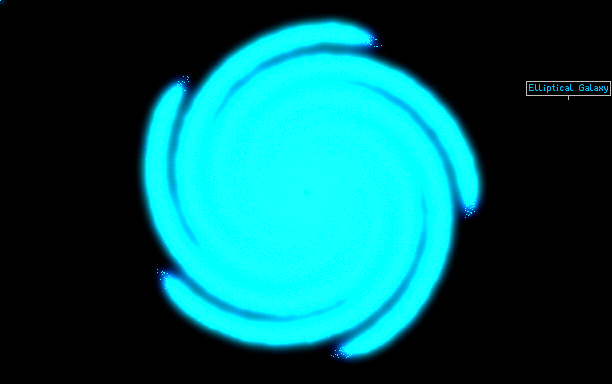Galaxy_Simulation by Skitz

Particles' positions and colors were calculated with a Lua script I put together. View with decorations enabled (preferably also with viewing mode 8) and unpause to watch the gravity diffuse the galaxy into a cloud of particles orbiting a central mass.
spiral
dontpress7
spore
galaxy
bigbang
universe
gravity
nothingdisplay
changegpmptemp
Comments
-
SFStudios 27th Oct 2016
 *galaxy
*galaxy -
SFStudios 27th Oct 2016
 Looks like an actual gravity +1
Looks like an actual gravity +1 -
Battleboy43 5th Jul 2016
 Remove the void and gpmp in the middle and you get a black hole simulation +1
Remove the void and gpmp in the middle and you get a black hole simulation +1 -
Skitz 5th Jul 2016
 Using the console, try setting the gravity pump's temperature to between 270 and 300 K so that the mass of the central hole changes and makes the galaxy more weakly or strongly attracted. The changes should make the simulation should play out differently and show things such as tighter orbits or a complete dissolution of the galaxy.
Using the console, try setting the gravity pump's temperature to between 270 and 300 K so that the mass of the central hole changes and makes the galaxy more weakly or strongly attracted. The changes should make the simulation should play out differently and show things such as tighter orbits or a complete dissolution of the galaxy. -
Lebothegizebo 5th Jul 2016
 yeah ok but call it galaxy simulation 2
yeah ok but call it galaxy simulation 2 -
Skitz 4th Jul 2016
 Should I change the galaxy into a spherical cloud now? Perhaps I can make it an elliptical rather than a spiral.
Should I change the galaxy into a spherical cloud now? Perhaps I can make it an elliptical rather than a spiral. -
msasterisk 4th Jul 2016
 @Skitz: the formula that I used for orbital velocity works in a similiar simulation I made in Gamemaker, guessing around at the unknown variable (orbital velocity at 1 unit) was pretty easy.
@Skitz: the formula that I used for orbital velocity works in a similiar simulation I made in Gamemaker, guessing around at the unknown variable (orbital velocity at 1 unit) was pretty easy. -
TheDarkAngel 4th Jul 2016
 looks better on 8. and no i dont read the description!
looks better on 8. and no i dont read the description! -
Hurrikan 4th Jul 2016
 More like a globular cluster, assuming that every perticle is one star.
More like a globular cluster, assuming that every perticle is one star. -
Skitz 3rd Jul 2016
 I used something I found more simple. I wish I could give some more psuedo-code, but it is not very easy trying to type into a comment box. I gave polar offsets (offsetX and offsetY) and got the velocity magnitude with a real formula (orbitVelMag = sqrt((G * M)/orbitDist)) where the mass (M) was just something random.
I used something I found more simple. I wish I could give some more psuedo-code, but it is not very easy trying to type into a comment box. I gave polar offsets (offsetX and offsetY) and got the velocity magnitude with a real formula (orbitVelMag = sqrt((G * M)/orbitDist)) where the mass (M) was just something random.